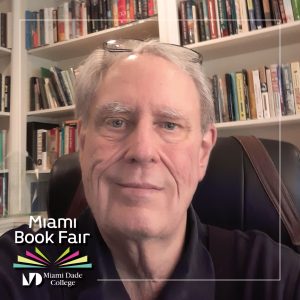
Longtime Friend of the Fair Stephen Colyer moved to North Carolina in 2016, when his wife’s career compelled them to relocate. But this lover of books – and barbeque! – has remained a committed member of the Friends family.
You lived in Miami for 21 years before putting down stakes in North Carolina, so you must remember what downtown was like before Book Fair helped turn it into the cultural hub it is today. What do you think that transformation has meant for Miami, and what has it meant for you?
Any celebration of the written word, authors, and their works is a good thing. And there are so many authors I never would have seen had it not been for the Fair. People like Isabel Allende – who I think is the finest storyteller in the world today – and Pat Conroy, a fellow South Carolinian who I met and spoke with several times at Book Fair. Turns out we were both at the state’s Department of Natural Resources.
What an unexpected bit of shared history.
Quite so! He had a department hat on and I immediately knew what it was. [laughs] Reza Aslan is another one; he gave one of the best presentations I’ve ever seen. He made the observation that anytime you have significant progress forward there’s always going to be a reaction, and that helps me understand what’s going on today. I remember Walter Isaacson said during a presentation that innovation is the intersection of art and science, and I think that’s such a cool way to capture the concept. And then there’s Dave Barry and Carl Hiaasen. No matter how crappy the world is, Dave Barry makes me laugh.
You and your wife do your best to make it back every year for the Fair – what are some of the benefits you most enjoy?
Sitting near the front. The older I get, the more my hearing and eyesight suck! [laughs] Sandra adores the Hospitality Lounge.
Tell me about a singular moment or experience you’ve had at the Fair.
There’s several, with one being meeting Pat Conroy; that was marvelous. Another is seeing the National Book Award winners. When the Fair started bringing them here it was just off the charts – that MBF is able to bring that level of talent en masse to Miami just two days after the awards are announced is incredible.
You’ve established a book fair yourself in North Carolina called Greensboro Bound – tell me about that.
Yes, I’m one of the founders; we kind of modeled Greensboro Bound after MBF but it’s held in May. I was at the Fair the year before our first one, waiting for a presentation to start and talking on the phone with our indie bookseller – he’s our Mitchell Kaplan counterpart – and he told me that we had gotten a yes from Carmen Maria Machado as our keynote. I was so excited that I yelled out, “We got Carmen Maria Machado?!?” And a woman a few rows in front of me turned around and said, “I’m Carmen Maria Machado.” [laughs] That was so cool.
That’s so funny! Is Greensboro Bound solely an annual thing, or do you also offer year-round programming?
We also do year-round programming, for kids and adults. We’ve got a great in-school program where we bring recorded author conversations into the classroom and combine those with books and lesson plans. It’s an optional thing for the county’s school libraries, and we’ve found that the ones that participate have seen circulation rates jump to 84% higher than the rates of the schools that don’t.
Wow!
Yeah, the theory is that the kids are falling in love with a genre or a specific author they’ve seen, and then they start looking for and checking out more books in that genre or by that author.
Speaking of falling in love with books, what’s the last great book that you read?
Two recent ones have really impressed me. One was a middle grade book, Refugee by Alan Gratz. We were trying to get it into the school program. I was amazed by it for two reasons: one, it was a really tight, four-story interconnected tale and he did it with limited vocabulary. Two, there was a cliffhanger every four to five pages – I was like, wow, there are some impressive writing skills going on here. The other one is a book of poetry by Ashley Lumpkin, and specifically a poem entitled “Bloody Sunday.” It was like capturing The Color Purple in a page and a half.
Interview by Elisa Chemayne Agostinho; responses have been edited for space and clarity.